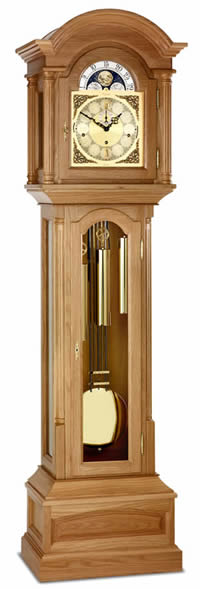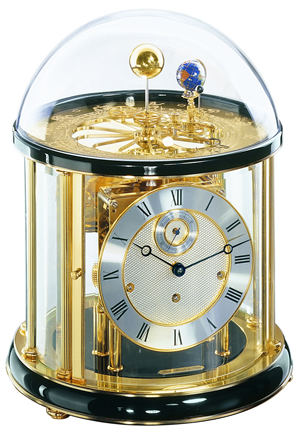New - Grandfather Clocks, Grandmother Clocks and Vienna Regulators
New Grandfather Clocks, Grandmother Clocks and Vienna Regulators designed and constructed by Frank and Barbara Redmile in their workshops at Oakside Classic Clocks. Frank and Barbara specialize in creating new Grandfather Clocks, Grandmother Clocks and Vienna Regulators and proudly continue to build longcase clocks in the tradition that has existed for some four hundred years. All Oakside longcase clocks are either an Oakside original design or a re-creation of a classic masterpiece of centuries past. Each clock is individually constructed to the highest standards using solid hardwood and to ensure your complete satisfaction, we fit "premier quality" mechanical clock movements - these masterpieces of horology are supplied by Kieninger of Germany - the oldest existing clock movement maker in the World. We are confident that the quality of our clocks is unsurpassed by any other maker and as we only sell direct to our customers our prices are not inflated to include retailers commissions!


All of the clocks displayed in The Oakside Gallery of Longcase Clocks have been designed and built by Frank and Barbara in their workshop, in the Village of Pamber Heath, near Tadley, Hampshire, England, UK. Our philosophy is "Quality First" - all of our clocks are hand-crafted to perfection and test run in our showroom prior to delivery. Setting such high standards limits the number of clocks we are able to construct each year, consequently a clock purchased from Oakside will remain very exclusive. We are confident that your new Oakside Longcase Clock will become an "Antique of the Future" and join the Masterpieces of the very early years of Longcase Clock Making.
We design and build to the highest specification, using the best of traditional and modern techniques. All of our longcase clock cabinets are constructed with kiln dried solid hardwood. To ensure that we are environmentally friendly, the timber we use in the construction of our clocks is certified with Chain of Custody certification to the FSC or PEFC standards. To compliment our cabinet making, we install very high quality movements and pendulums, Kieninger®, the oldest existing manufacturer of mechanical movements in the world, supplies these items. All of our dials are custom made to our specifications in solid brass by Bedford Dials Ltd of Tenbury Wells. Every clock is hand sanded prior to the application of five coats of hard satin lacquer - this finish provides the cabinet with a superb "low maintenance" protection that will not require further waxing - just an occasional rub and dusting with a soft cloth will see the timber gradually acquire the patina associated with loving ownership.
The structure of our web site is designed for easy navigation. If a particular model in the "Clock Gallery" takes you eye, you will find a link to its dedicated "Full Details" page, from there you will find links to the clocks "Large Images". You can also proceed to the "Options & Prices" page where you can personalize your chosen design and obtain a "delivery inclusive" instant price quotation. Our showroom normally has an example of each of our clock models on display; we will be delighted if you are able to visit to inspect our clocks prior to placing an order. If you are unable to visit, we will send you timber samples, to assist in your selection.

When you place an order for an Oakside clock we require a deposit of £250.00 (€250.00) and the quoted clock price including delivery is then fixed! Frank and Barbara will personally deliver and install your clock in the counties surrounding Hampshire; deliveries elsewhere in mainland UK will be done by our dedicated delivery team. We have frequently supplied clocks to customers in Europe, the USA and to Australia & New Zealand - Please do not hesitate in enquiring about export sales to any part of the World.
This web site is our shop window to the World. We endeavor to ensure that the photographs and the detailed specifications contained, provide comprehensive information about our clocks, however, we will welcome your phone call or e-mail if you have any further questions! We invite you to make a personal inspection, by visiting our showroom where we have examples of most of our clocks on display! We are very informal, but please phone Frank and Barbara to arrange a viewing appointment.
New Longcase Clock or an Antique?
Nearly all of our customers have mentioned that they had previously spent time looking for an Antique Longcase Clock and what they also mentioned is that any clock over fifty years old is commonly described, by the vendor as an antique, instead of just old! They had also found it difficult to ascertain the real value of any particular clock they had seen! This brings us to the following questions - what is a genuine antique, how do you ascertain its quality, what is its real value, what will it cost to maintain and will it keep good time?
The Longcase clock in its earliest form evolved from Bracket or Lantern clocks, these had verge escapements and its action required the pendulum to describe a very wide swing - too wide to realistically enclose within a cabinet - these clocks often had only an hour hand as time-keeping, judged by modern standards, was relatively poor. The invention of the Anchor Escapement which requires a much smaller arc of swing, improved time-keeping dramatically but also enabled the enclosure of the pendulum and the weights within a cabinet - this had to be very tall to allow sufficient drop of the drive weights, hence the name "long case" - this also overcome the problem of people, pets and draughts affecting the motion of the exposed pendulum.

The longcase clocks of the period 1660 - 1720 generally had square dials and often had cabinets adorned with Marqueterie, many had movements that required winding every 30 hours. The Arch dial appeared about 1710 - Makers desire to add more functions to their clocks, necessitated the enlargement of the dial and adding the top arch to the top of the existing square dials, accommodated the extra features! For a while Square & Arched Dial clocks continued to be made but by 1720 the Arched dial had almost entirely displaced the square dial. The advance in the sciences of horology and skills of movement makers both combined to allow movements to run for longer periods between rewinding - eight day movements displaced the 30 hour type and eradicated the chore of daily winding. The invention of the Dead Beat Escapement by George Graham FRS in 1715 and the Temperature Compensating Pendulum by John Harrison of Pontefract in 1729, together, very dramatically improved the ability of longcase clocks to provide accurate and consistent time-keeping! All of these desirable technical features will be found in the "high-quality" mechanical movements and pendulums produced by Kieninger of Germany and incorporated into our longcase clocks.
Until the 1750's the dominating influence of the Clockmakers Company (Guild of Master Clock Makers) and the competitive pride of the eminent Makers, together ensured that early longcase clocks were built to very high standards - clocks that have survived from that period now command very high prices. The gradual demise of the influence of the Guild is evident in the declining standards of construction, quality and in purity of style of post 1750 clocks - lesser makers attempts to capture sales often brought together an amalgamation of features and styles from different centuries but frequently failed to create a clock of merit! Although highly skilled Makers continued to create very high quality clocks, anybody with woodworking skills could now build a clock and many later clocks were built by village or town carpenters, men skilled at building barns and coffins but lacking the design flair for building fine pieces of furniture, consequently, antique clocks built after 1750 vary considerably in style, quality and in their ability to keep good time! The introduction of mass produced clocks around 1900 also furthered the decline in quality but did make longcase clocks affordable to the masses!

The value of an antique clock is difficult to accurately assess but many specialist auction houses publish the results of their sales and this is probably the best indicator of real values! The Pedigree of the Clock Maker, especially historical references etc, the Provenance of the Clocks Ownership throughout its lifetime and absolute originality, being the most important criteria!
"The oldest surviving longcase clock was once brand new." The eminent Clock Makers of the 18th Century would have provided Patrons with an opportunity to incorporate the latest trends in homological design and fashion into their new longcase clocks. Oakside is probably unique in continuing the tradition of providing customers with a choice of timbers and other build options for each clock!

Other things to consider! The vast majority of longcase clocks were built for very large houses - often standing between seven and eight feet tall, consequently, if they are still in their original form they will be far too high for modern homes. Through the centuries, most have been the subject of alteration to follow later trends in styling and in movement design, many have been reduced in height to fit smaller houses and almost all have been prone to infestation through lack of timber treatment and to attacks of dry rot after standing on damp solid floors. Regarding the movements - these can be very reliable - a periodic clean of the wheels and pinions and lubricating the pivots should provide reasonable service but damaged or broken parts will have to be custom made and will be very expensive to replace!
The differences in quality and style that occurred during the middle centuries of clock making, continue to exist today - buyers of new clocks can now choose between those displayed in the High Street shops and on-line auction sites - most of which are either from China or massed produced and imported from America; characterized by their distinctive and flamboyant styles, or they may purchase a "high quality" hand-crafted clock, built in the true English style and made by specialist like Oakside!
Frank and Barbara are confident that the pleasure and personal satisfaction experienced when creating each clock, will pass to the new owner of each of Oakside's Longcase Clocks!
Your decision to purchase a new "High Quality" hand-crafted Longcase clock from a specialist Clock Maker like Oakside, a "mass produced" import from the internet or an Antique, will depend very much on your personal preferences and perhaps your budget but unless your home has rooms with high ceilings, the height of an original and unmodified antique clock may well eliminate it from your considerations! All of the floor clocks in the Oakside range have been deliberately designed to fit the ceiling heights of modern homes but for houses with higher ceilings we will build taller versions of all of our clocks.! To keep your clock in perspective with its setting, we recommend a minimum distance of 10 inches between the top of the clock and the ceiling. A Grandfather Clock will normally be ideal in a Hall where viewers will be standing but in contrast, a Grandmother Clock may suit a room where viewers will generally be sitting down. In most cases the center of the dial should be approximately level or slightly higher than the average adult eye-line.
Regarding values - Longcase clocks made in the early seventeenth century by eminent Makers and that have entirely retained their original form, movement and dial, will command the highest prices. In the majority of cases, any undocumented alterations, especially reductions in height or a change of movement or dial will massively detract from a clocks value!









